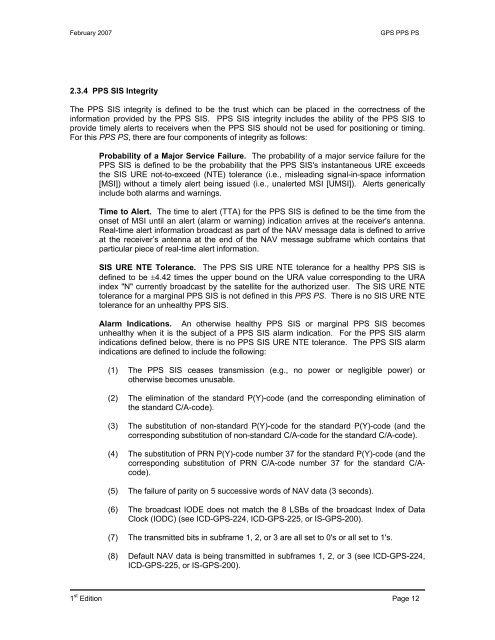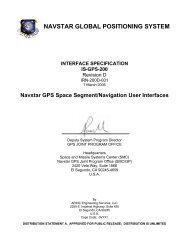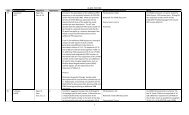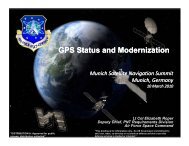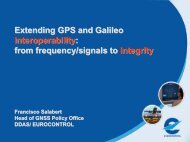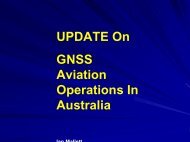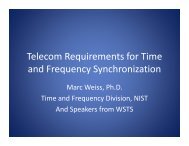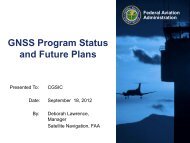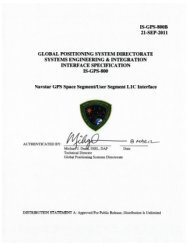Precise Positioning Service Performance Standard - GPS.gov
Precise Positioning Service Performance Standard - GPS.gov
Precise Positioning Service Performance Standard - GPS.gov
You also want an ePaper? Increase the reach of your titles
YUMPU automatically turns print PDFs into web optimized ePapers that Google loves.
February 2007<br />
<strong>GPS</strong> PPS PS<br />
2.3.4 PPS SIS Integrity<br />
The PPS SIS integrity is defined to be the trust which can be placed in the correctness of the<br />
information provided by the PPS SIS. PPS SIS integrity includes the ability of the PPS SIS to<br />
provide timely alerts to receivers when the PPS SIS should not be used for positioning or timing.<br />
For this PPS PS, there are four components of integrity as follows:<br />
Probability of a Major <strong>Service</strong> Failure. The probability of a major service failure for the<br />
PPS SIS is defined to be the probability that the PPS SIS's instantaneous URE exceeds<br />
the SIS URE not-to-exceed (NTE) tolerance (i.e., misleading signal-in-space information<br />
[MSI]) without a timely alert being issued (i.e., unalerted MSI [UMSI]). Alerts generically<br />
include both alarms and warnings.<br />
Time to Alert. The time to alert (TTA) for the PPS SIS is defined to be the time from the<br />
onset of MSI until an alert (alarm or warning) indication arrives at the receiver's antenna.<br />
Real-time alert information broadcast as part of the NAV message data is defined to arrive<br />
at the receiver’s antenna at the end of the NAV message subframe which contains that<br />
particular piece of real-time alert information.<br />
SIS URE NTE Tolerance. The PPS SIS URE NTE tolerance for a healthy PPS SIS is<br />
defined to be ±4.42 times the upper bound on the URA value corresponding to the URA<br />
index "N" currently broadcast by the satellite for the authorized user. The SIS URE NTE<br />
tolerance for a marginal PPS SIS is not defined in this PPS PS. There is no SIS URE NTE<br />
tolerance for an unhealthy PPS SIS.<br />
Alarm Indications. An otherwise healthy PPS SIS or marginal PPS SIS becomes<br />
unhealthy when it is the subject of a PPS SIS alarm indication. For the PPS SIS alarm<br />
indications defined below, there is no PPS SIS URE NTE tolerance. The PPS SIS alarm<br />
indications are defined to include the following:<br />
(1) The PPS SIS ceases transmission (e.g., no power or negligible power) or<br />
otherwise becomes unusable.<br />
(2) The elimination of the standard P(Y)-code (and the corresponding elimination of<br />
the standard C/A-code).<br />
(3) The substitution of non-standard P(Y)-code for the standard P(Y)-code (and the<br />
corresponding substitution of non-standard C/A-code for the standard C/A-code).<br />
(4) The substitution of PRN P(Y)-code number 37 for the standard P(Y)-code (and the<br />
corresponding substitution of PRN C/A-code number 37 for the standard C/Acode).<br />
(5) The failure of parity on 5 successive words of NAV data (3 seconds).<br />
(6) The broadcast IODE does not match the 8 LSBs of the broadcast Index of Data<br />
Clock (IODC) (see ICD-<strong>GPS</strong>-224, ICD-<strong>GPS</strong>-225, or IS-<strong>GPS</strong>-200).<br />
(7) The transmitted bits in subframe 1, 2, or 3 are all set to 0's or all set to 1's.<br />
(8) Default NAV data is being transmitted in subframes 1, 2, or 3 (see ICD-<strong>GPS</strong>-224,<br />
ICD-<strong>GPS</strong>-225, or IS-<strong>GPS</strong>-200).<br />
1 st Edition Page 12


